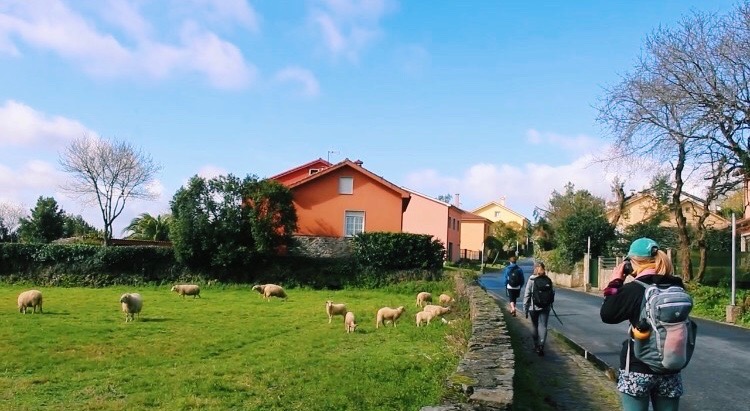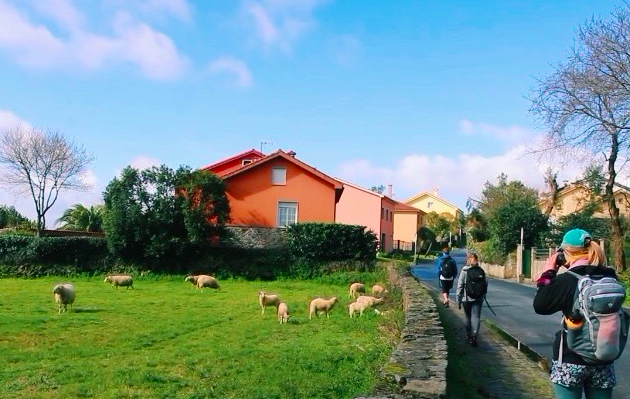
Pilgrims drop to their knees, tears of joy hit the ancient stone, Scottish music plays, church bells ring, and the cathedral of Santiago de Compostela towers above the square.
El Camino de Santiago, La Chemin de Saint-Jacques, or The Way of Saint James. The Camino began after the death of Saint James in 812 AD. Originally a religious pilgrimage, thousands of pilgrims journeyed to Santiago de Compostela, located in northwestern Spain, Galicia, where the rests of Saint James lie. The pilgrims believed that their journey to Santiago honored Saint James, and that, in return, he would grant them a healthy and happy life.
Today the Camino is a journey for people of all religions, beliefs, and backgrounds. While Santiago de Compostela is still the final destination, the reasons people choose to walk vary greatly. A German man walked in hope of finding happiness after getting fired from his job and losing his wife to breast cancer. A French couple walked with their new born baby to escape the chaos of a big city. A Spanish man walked to meet new people because he believes God is within everyone.
I decided to walk the Camino, along with three friends, as a part of my end of the year research project. After spending a year abroad in Zaragoza, Spain, my friends and I mastered both Spanish and traveling alone. We reserved albergues to sleep in, prepared our backpacks, and got on our 13-hour overnight train from Zaragoza to Arzúa.
Just in time for our arrival in Arzúa, the skies opened and the rain came pouring down. As we walked from Arzúa to Melíde to Pedrouzo to Santiago we embraced the rain, just like everything else. We embraced walking in soaking wet clothes, and sleeping in freezing cold weather. We walked alongside Australians, Germans, Japanese, sheep, and chicken. We saw ancient churches, green rolling hills, waterfalls, and local Spaniards carrying gigantic legs of jamón ibérico. We smelt coffee and freshly made bread from the panaderias.
As we arrived at our final destination before Santiago, I could feel the excitement in the air. Everyone staying in the albergue joined in the common room and we shared stories with each other about our experiences on the Camino. I was amazed by the diversity in the room. Despite our different religions, beliefs, backgrounds, and languages, we sat in the common room like a family who had all endured the same difficulties, and all had the same final destination.
On the journey towards Santiago de Compostela, I met a Spanish man, José Antonio. José has been walking around the world for the past ten years with the goal of spreading God’s word. José told me, “Hay que estar abierto y aprovechar de todo”, meaning, you must be open minded and take advantage of everything.
As I arrived at the cathedral in Santiago de Compostela, I immediately was full of joy. I thought of the advice José told me, and realized it was a true lesson of the Camino de Santiago. You learn to be open-minded and accepting of the diverse group of amazing, inspiring people you meet. You learn to take advantage of everything because you are constantly moving and don’t have time to waste.
The final destination of the Camino, Santiago de Compostela, is truly beautiful. The beauty is in the ancient Romanesque and Gothic architecture, and the Cathedral towering above you. But most importantly, it is the people standing in the square who journeyed to get there. It is the tears of joy falling onto the ancient stone.
Dear Reader: This page may contain affiliate links which may earn a commission if you click through and make a purchase. Our independent journalism is not influenced by any advertiser or commercial initiative unless it is clearly marked as sponsored content. As travel products change, please be sure to reconfirm all details and stay up to date with current events to ensure a safe and successful trip.

Do you have any video of that? I’d love to find out more details.